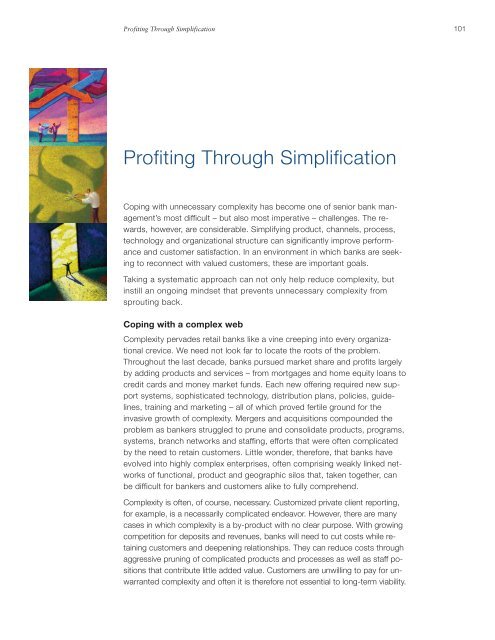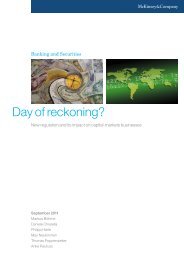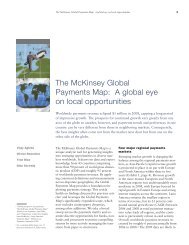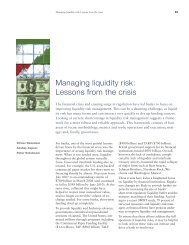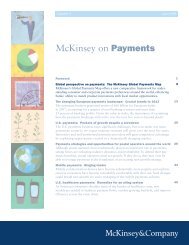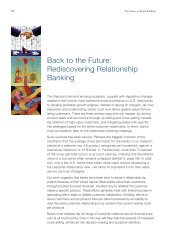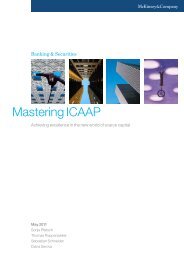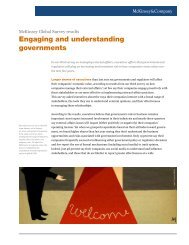Profiting Through Simplification - McKinsey & Company
Profiting Through Simplification - McKinsey & Company
Profiting Through Simplification - McKinsey & Company
You also want an ePaper? Increase the reach of your titles
YUMPU automatically turns print PDFs into web optimized ePapers that Google loves.
<strong>Profiting</strong> <strong>Through</strong> <strong>Simplification</strong><br />
101<br />
<strong>Profiting</strong> <strong>Through</strong> <strong>Simplification</strong><br />
Coping with unnecessary complexity has become one of senior bank management’s<br />
most difficult – but also most imperative – challenges. The rewards,<br />
however, are considerable. Simplifying product, channels, process,<br />
technology and organizational structure can significantly improve performance<br />
and customer satisfaction. In an environment in which banks are seeking<br />
to reconnect with valued customers, these are important goals.<br />
Taking a systematic approach can not only help reduce complexity, but<br />
instill an ongoing mindset that prevents unnecessary complexity from<br />
sprouting back.<br />
Coping with a complex web<br />
Complexity pervades retail banks like a vine creeping into every organizational<br />
crevice. We need not look far to locate the roots of the problem.<br />
<strong>Through</strong>out the last decade, banks pursued market share and profits largely<br />
by adding products and services – from mortgages and home equity loans to<br />
credit cards and money market funds. Each new offering required new support<br />
systems, sophisticated technology, distribution plans, policies, guidelines,<br />
training and marketing – all of which proved fertile ground for the<br />
invasive growth of complexity. Mergers and acquisitions compounded the<br />
problem as bankers struggled to prune and consolidate products, programs,<br />
systems, branch networks and staffing, efforts that were often complicated<br />
by the need to retain customers. Little wonder, therefore, that banks have<br />
evolved into highly complex enterprises, often comprising weakly linked networks<br />
of functional, product and geographic silos that, taken together, can<br />
be difficult for bankers and customers alike to fully comprehend.<br />
Complexity is often, of course, necessary. Customized private client reporting,<br />
for example, is a necessarily complicated endeavor. However, there are many<br />
cases in which complexity is a by-product with no clear purpose. With growing<br />
competition for deposits and revenues, banks will need to cut costs while retaining<br />
customers and deepening relationships. They can reduce costs through<br />
aggressive pruning of complicated products and processes as well as staff positions<br />
that contribute little added value. Customers are unwilling to pay for unwarranted<br />
complexity and often it is therefore not essential to long-term viability.
102 The Future of Retail Banking<br />
Five major factors drive complexity:<br />
• Product portfolio. Years of operating in a product-centric mode have led<br />
to a plethora of products, variations, special offerings and exceptions that<br />
require systems, guidelines, policies, training and ongoing support regardless<br />
of the value they currently add to the organization.<br />
• Distribution channels. Technological advances continue to enable new<br />
and more convenient channels, leading customers to gradually abandon<br />
less convenient alternatives.<br />
• Processes. As products and channels expand, so do processes and often<br />
duplication of processes, as in coordinating origination processes across<br />
product groups. Complexity can stem from unnecessary process steps,<br />
from duplicative work and from unneeded handoffs.<br />
• Technology. Banks depend heavily on technology systems often comprised<br />
of multiple platforms and linkages. These typically require extensive<br />
training, frequent costly updating, high security and 24-hour support.<br />
• Organizational structure. As banks pursue new growth organizational<br />
structures become more intricate, with product, back office, channel, IT<br />
and other teams frequently involved in cross-matrix interactions.<br />
As these key drivers illustrate, complexity is an organization-wide problem.<br />
Consequently, a change in one area generally requires changes in some or all<br />
of the others. Tackling the problem demands a systematic approach.<br />
A systematic approach to simplification<br />
Controlling complexity must be an institution-wide effort that has the full support<br />
of senior management. Uncertainty about how and where to begin such<br />
an extensive task undoubtedly has led most banks to largely evade it. However,<br />
a comprehensive and systematic approach will result in gradual ongoing<br />
improvement in customer satisfaction and bottom-line performance. Three<br />
fundamental steps are critical for success: establishing a complexity baseline,<br />
designing a customer-centric program plan, then diligently implementing the<br />
plan and inculcating a simplification mindset.<br />
• Establish a complexity baseline. This vital first step – often overlooked –<br />
provides a solid foundation on which to build a program that will actually<br />
be capable of rooting out pointless complexity. Identifying and applying<br />
a series of relevant metrics across the areas that drive most complexity<br />
can help reveal where it is most pervasive, and how it may also be driv-
<strong>Profiting</strong> <strong>Through</strong> <strong>Simplification</strong><br />
103<br />
ing unneeded complexity in other areas. When creating a baseline, it is<br />
also important to estimate the relative cost and difficulty of simplification<br />
in those areas where it is needed. This baseline information will provide a<br />
footing for identifying hot spots and prioritizing simplification tasks<br />
across the organization.<br />
• Design a customer-centric plan. The most effective approach is often one<br />
which takes a customer-centric focus. This means starting with the product<br />
portfolio, then moving on to address distribution channels and<br />
processes, and lastly operations and technology. Products, versions and<br />
exceptions tend to proliferate over time with little attention paid to discontinuing<br />
weak performers. Is offering 25 types of credit cards, for example,<br />
really important to maintaining the current customer base? Reducing the<br />
number of card types would simplify marketing and back-office operations,<br />
and would lead to bottom-line contributions from each. To gain a<br />
clear perspective on which products are truly driving profitability, and<br />
which are driving only more complexity, we suggest banks develop a grid<br />
which measures products by both level (high vs. low) and kind (good vs.<br />
bad) of complexity (Exhibit 1).<br />
Exhibit 1<br />
Assessing product portfolio complexity<br />
Size of bubble indicates number of accounts<br />
Good<br />
70% products<br />
with high and<br />
bad complexity<br />
Products to keep<br />
Products to<br />
migrate/standardize<br />
Kind of<br />
complexity<br />
(product margin)<br />
Bad<br />
Low<br />
High<br />
Level of complexity<br />
(Number of products in same segment, if product is actively offered, number of exceptions)<br />
Note: Product portfolio assessed based on bank’s strategy regarding products and complexity KPIs<br />
Source: <strong>McKinsey</strong> analysis
104 The Future of Retail Banking<br />
Exhibit 2<br />
Evaluating complexity/cost of distribution channels<br />
Main key<br />
performance<br />
indicators<br />
Internet<br />
VRU<br />
Products/channels to consider discontinuing<br />
Mail<br />
Call<br />
center<br />
Branches<br />
Product 1<br />
Percentage of transactions<br />
75%<br />
20%<br />
0%<br />
5%<br />
0%<br />
Cost per transaction<br />
$0.7<br />
$1<br />
$2<br />
$20<br />
$50<br />
Product 2<br />
Percentage of transactions<br />
80%<br />
5%<br />
0%<br />
5%<br />
10%<br />
Cost per transaction<br />
$0.7<br />
$1<br />
$2<br />
$20<br />
$50<br />
Product 3<br />
Percentage of transactions<br />
75%<br />
0%<br />
0%<br />
0%<br />
25%<br />
Cost per transaction<br />
$0.7<br />
$1<br />
$2<br />
$20<br />
$50<br />
Product 4<br />
Percentage of transactions<br />
65%<br />
5%<br />
0%<br />
0%<br />
30%<br />
Cost per transaction<br />
$0.7<br />
$1<br />
$2<br />
$20<br />
$50<br />
Low<br />
Level of complexity<br />
High<br />
Note: Level of complexity was based on variability of channels (e.g., number of channels used) and cost of channel used<br />
Source: <strong>McKinsey</strong> analysis<br />
Banks should also consider whether the use of all channels for all products<br />
and services is necessary. Discontinuing channels that are seldom<br />
used for a particular products or services can bring immediate gains in<br />
simplicity (Exhibit 2). Similarly, processes often have unnecessary steps,<br />
duplicated efforts and relatively pointless handoffs to certain areas or<br />
departments; weeding out this type of complexity will streamline<br />
processes, and thereby save both time – including the customer’s – and<br />
expense (Exhibit 3).<br />
<strong>Simplification</strong> in the product, channel and process areas will underscore<br />
related opportunities in the bank’s technological and organizational infrastructures.<br />
Experienced IT managers know that platform redundancies,<br />
frequent systems updating, ongoing technical training and system incompatibility<br />
issues often add needless complications and expense to<br />
bank technology systems. Moreover, organizations frequently grow new<br />
limbs in these core areas to accommodate additions in products, channels<br />
and processes. Uprooting unwanted complexity in technological<br />
and organizational infrastructures is therefore usually much easier after<br />
eliminating it in other areas.
<strong>Profiting</strong> <strong>Through</strong> <strong>Simplification</strong><br />
105<br />
Exhibit 3<br />
Measuring complexity of key processes by product<br />
Activities<br />
Performance<br />
indicators<br />
Account<br />
openings<br />
Transactions<br />
Periodic<br />
transactions<br />
Administrative<br />
Product 1<br />
<strong>Through</strong>put time (days)<br />
10<br />
1<br />
Number of exception cases<br />
30,000<br />
70,000<br />
N/A<br />
6,000<br />
Product 2<br />
<strong>Through</strong>put time (days)<br />
5<br />
1<br />
6<br />
Number of exception cases<br />
45,000<br />
50,000<br />
60,000<br />
3,000<br />
Product 3<br />
<strong>Through</strong>put time (days)<br />
20<br />
8<br />
1<br />
Number of exception cases<br />
60,000<br />
100,000<br />
60,000<br />
30,000<br />
Product 4<br />
<strong>Through</strong>put time (days)<br />
5<br />
53<br />
Number of exception cases<br />
100,000<br />
300,000<br />
N/A<br />
45,000<br />
Source: <strong>McKinsey</strong> analysis<br />
Increase STP rate mainly<br />
by process (not IT)<br />
changes (e.g., allow fewer<br />
exceptions in forms)<br />
Complexity level<br />
Low<br />
Medium<br />
High<br />
• Implement and sustain simplification. With a clearer view of the bank’s unnecessary<br />
complexity, management can prioritize simplification efforts, establish<br />
budget allocations, assign task responsibilities and evaluate progress.<br />
Unless there is a sustained effort to curb its re-growth, unwarranted complexity<br />
will rapidly grow back and erase hard-won simplicity. Success<br />
therefore demands an ongoing institution-wide effort to prevent the addition<br />
of unnecessary processes and systems. Senior leadership can assign<br />
ownership of simplification efforts, set management objectives and budgets,<br />
and develop tools to track improvements. These steps are critical to<br />
ensure simplification will remain a priority.<br />
* * *<br />
Bank managers know that complexity can impede both organizational performance<br />
and customer satisfaction. By adopting a holistic perspective of<br />
complexity’s five leading drivers, financial institutions can give customers<br />
the banking experience they want while also simplifying processes, channels<br />
and products.
About <strong>McKinsey</strong> & <strong>Company</strong><br />
<strong>McKinsey</strong> & <strong>Company</strong> is a management consulting firm that helps many of the<br />
world’s leading corporations and organizations address their strategic challenges,<br />
from reorganizing for long-term growth to improving business performance<br />
and maximizing profitability. For more than 80 years, the firm’s primary<br />
objective has been to serve as an organization’s most trusted external advisor<br />
on critical issues facing senior management. With consultants in more than 40<br />
countries around the globe, <strong>McKinsey</strong> advises clients on strategic, operational,<br />
organizational and technological issues.<br />
<strong>McKinsey</strong>’s Consumer & Small Business Banking Practice serves leading<br />
North American banks on issues of strategy and growth, operations and technology,<br />
marketing and sales, organizational effectiveness, risk management<br />
and corporate finance. Our partners and consultants provide expert perspectives<br />
on a range of topics including corporate strategy, business model redesign,<br />
product and market strategy, distribution and channel management,<br />
the impact of financial services regulation and performance improvement.<br />
The following <strong>McKinsey</strong> consultants and experts contributed to<br />
this compendium:<br />
Whit Alexander<br />
Daina Graybosch<br />
James McKay<br />
Greg Phalin<br />
Philip Bruno<br />
Tommy Jacobs<br />
Howard Moseson<br />
Leonardo Rinaldi<br />
Robert Byrne<br />
Piotr Kaminski<br />
Sudip Mukherjee<br />
Pablo Simone<br />
Liam Caffrey<br />
Rami Karjian<br />
Fritz Nauck<br />
Vik Sohoni<br />
Prasenjit<br />
Chakravarti<br />
David Chubak<br />
Marco De Freitas<br />
Benjamin Ellis<br />
Akshay Kapoor<br />
Catharine Kelly<br />
Nick Malik<br />
Robert Mau<br />
Sandra Nudelman<br />
Marukel Nunez<br />
Pradip Patiath<br />
John Patience<br />
Dorian Stone<br />
Sarah Strauss<br />
Ameesh Vakharia<br />
Tim Welsh<br />
Contact<br />
For more information, contact:<br />
Nick Malik<br />
Director<br />
(212) 446-8530<br />
nick malik@mckinsey.com<br />
Christopher Leech<br />
Director<br />
(412) 804-2718<br />
chris leech@mckinsey.com<br />
Marukel Nunez<br />
Principal<br />
(212) 446-7632<br />
marukel nunez@mckinsey.com
Financial Services Practice<br />
November 2010<br />
Designed by Hudspith Design<br />
Copyright © <strong>McKinsey</strong> & <strong>Company</strong><br />
www.mckinsey.com/clientservice/financial_services


